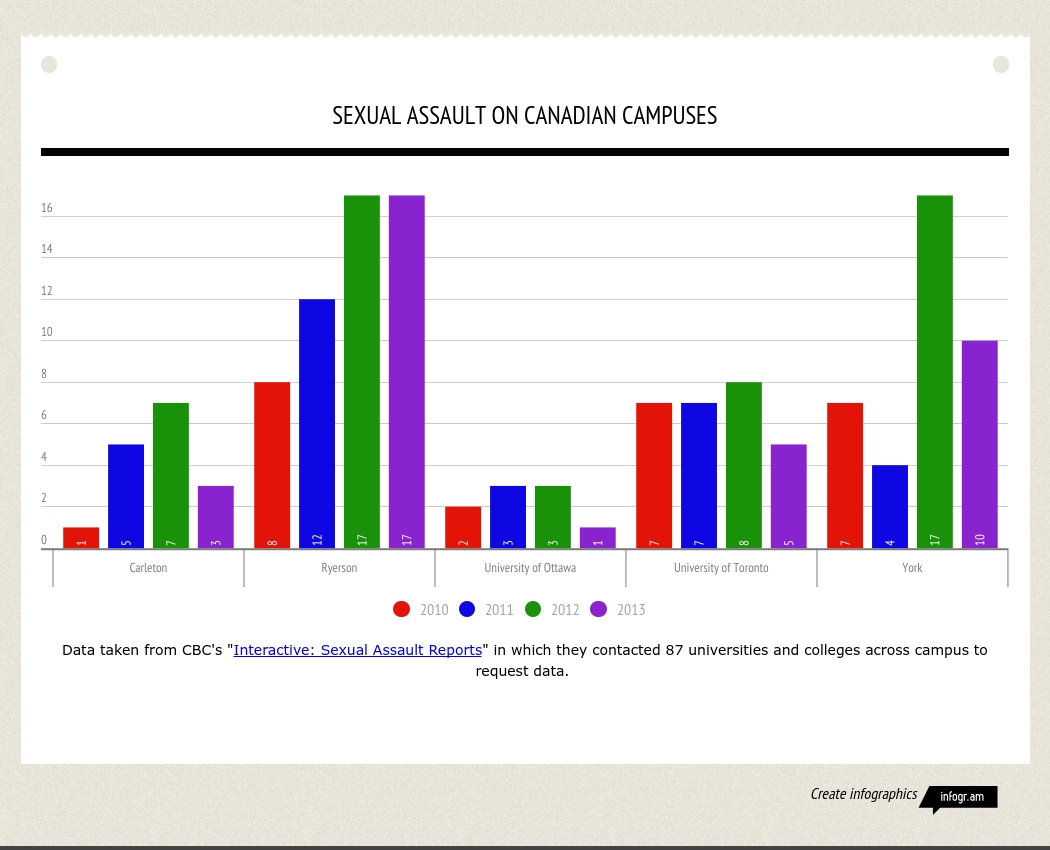First-year English student Amanda Horvath moved into her Carleton residence just two weeks ago, but she said the fear of sexual assault is already on her mind.
“I’m concerned,” she said. “Being a young woman, it happens.”
Two weeks of living in Carleton’s Lanark House, Horvath said she is still learning the gist of university life—good and bad.
“Some of the guys can get out of hand and make some snide comments and talk really crudely about some of the girls on the floor,” she said.
First-year female students at universities across North America are most likely to be sexually assaulted in the first three months of this semester. Experts have warned policymakers on college campuses of this period, which they call the “red zone.”
A 2007 study conducted by the U.S. Justice Department found more than 50 per cent of college sexual assaults occur from August to November, with October as the most prevalent month. According to the study, which involved 16,000 female students at two American universities, almost 20 per cent of female students entering their second year of university had been sexually assaulted before.
Other American studies found similar increases in the rate of sexual assaults for first-year students during the fall semester. No major Canadian studies of the red zone period have been conducted so far.
Rena Bivens, a journalism and communications professor at Carleton who studies gender-based violence, said the spike in sexual assault is a result of multiple factors, but partly due to normalized attitudes about sexual assault in traditional frosh culture.
“Frosh culture can encourage this idea of non-consensual sex, either explicitly or implicitly,” Bivens said.
Bivens said first-year students often have misunderstandings about sexual assault and consent and are inexperienced with intimate relationships.
“Around the beginning of the school year there’s this energy around first-years and new students that you’re away from home and you’ve got to become this new person,” she said. “And it looks like sex is a part of this and they’re not quite sure how to get it.”
The increase in sexual assaults is also due to more parties with alcohol and drugs early in the semester and the idea university is a time when you should have sex with lots of people, Bivens said.
A 2014 University of Windsor study found only four per cent of women had ever attended an “in-depth workshop or training on sexual assault or rape” prior to arriving at university.
Bivens said there is a lack of understanding among many first-year students about what consent is. She noted, however, that the last two years have been great in terms of getting the issue on the table.
Yami Msosa, public education co-ordinator at the Sexual Assault Support Centre (SASC) of Ottawa, said her organization is using education to try to reduce the number of assaults during the red zone period and to support victims.
Msosa said SASC Ottawa focuses much of its efforts during the red zone period because of the higher number of sexual assaults.
“We try to ensure that our support line coverage is 110 per cent,” she said. “We [do] outreach with students by going to frosh welcome week events and fairs.”
A study by the CBC found Ryerson University had the highest number of reported sexual assaults on campus between 2009 and 2013 at 57 cases. By comparison, Carleton and the University of Ottawa (U of O) had 19 and 10 reported incidents, respectively.
Sonya Nigam, director of U of O’s human rights office, said the university recently implemented a sexual violence protocol and will soon publish its policy on sexual violence. This comes after several high-profile incidents of sexual assault at the university in 2014.
The protocol sets the expected behaviour for the U of O community and explains what to do if an incident of sexual assault happens, said Nigam, who is co-chairing the protocol subcommittee.
“We felt it was really important to get the protocol, at least in interim, established now in September,” she said.
Nigam said the university focuses on sexual violence training for residence dons, protection services, and the human rights office during the red zone period.
Representatives from the Ottawa Rape Crisis Centre and the French language Centre d’aide et de lutte contra les agressions à caractère sexuel (CALACS) will be available on U of O’s campus one day a week during the fall semester to provide service directly to students, Nigam said.
To help lower the number of assaults that happen during the red zone period, Bivens said it is most important to have conversations about consent.
“There’s not a lot of realistic depictions of what sex looks like or what it can look like,” she said. “These are some of the problems people are facing when they’re even trying to discuss consent with people.”
Bivens said first-year students should think of themselves as “active bystanders” in social situations.
“Talk more with people and don’t let things get to where it looks like a person is taking advantage of another person or that person looks really drunk,” she said.
First-year Carleton social work student Sydney Duncan, who does not live on residence, said she would be more concerned about being sexually assaulted if she had lived on residence, but believes there are now good measures in place to protect and help students.
Duncan said she was impressed with efforts from frosh facilitators to ensure safety for those leaving night frosh events.
“My friends tried to refuse [an escort back to residence] but the escorts wouldn’t let them even if they didn’t talk,” she said. “They just wanted to make sure they got home safely.”
Horvath agrees with her.
“I have my first night class and the discussion group goes until 10 at night,” she said. “There’s a service to walk you home so I’ll definitely use that.”






